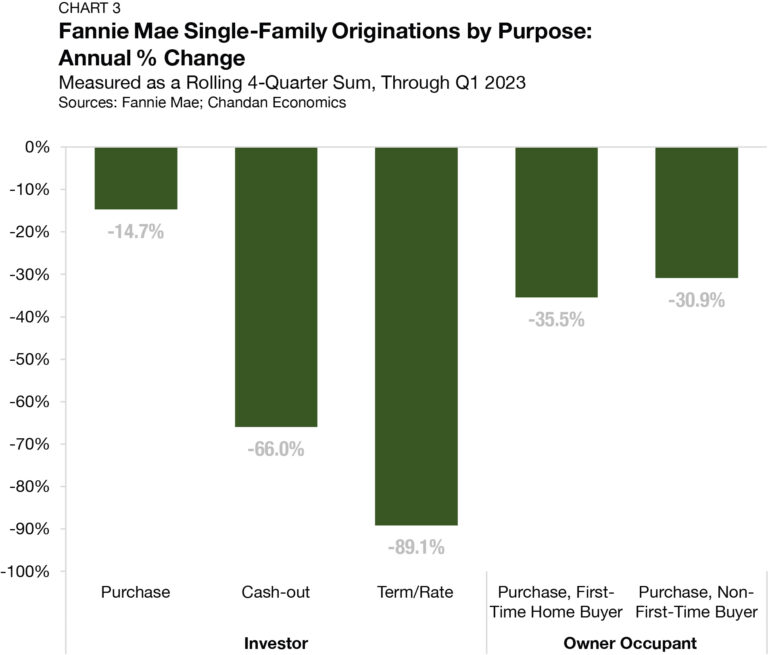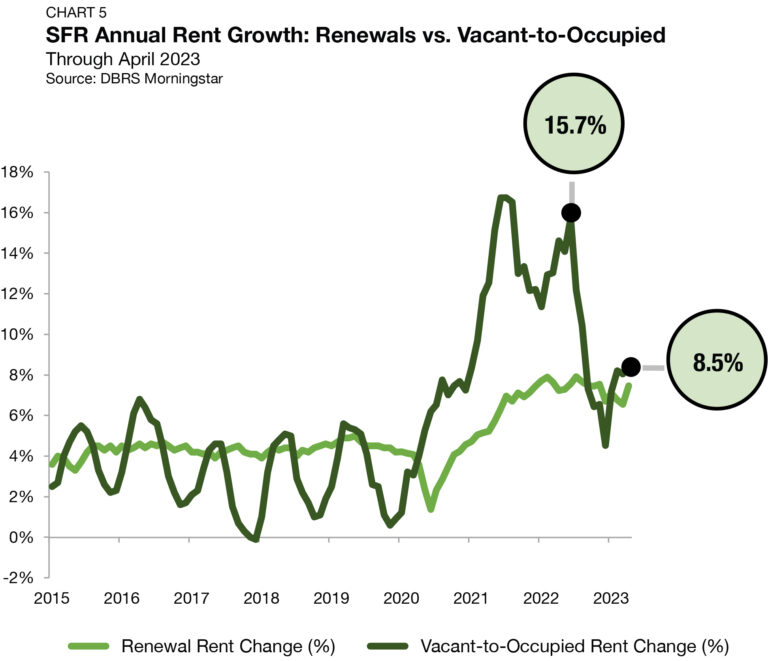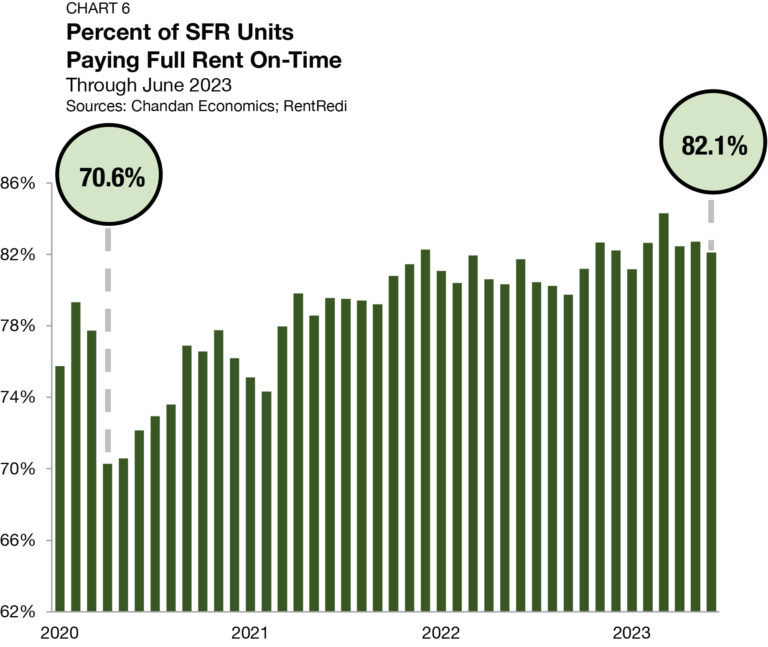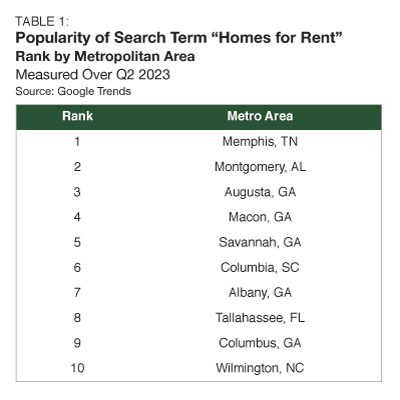In all market cycles, commercial real estate firms are better positioned to achieve successful results with leaders who are strong, confident, and authentic, qualities demonstrated by the dozens of speakers at the 2025 Real Estate Pride Roundtable in New York City.
Single-Family Rental Investment Trends Report Q3 2023
SFR Construction Starts Hit Another High as Cap Rates Continue Rising
Key Findings
- SFR/BTR construction starts reached a new record high in the first quarter of 2023, accounting for 7.3% of all single-family starts.
- Rent growth increased slightly, resuming pre-pandemic seasonal patterns.
- Cap rates reached 6.2% in the second quarter, an increase of 16 bps over the previous quarter.
Table of Contents
State of the Market
Amid a challenging interest rate climate, the single-family rental (SFR) sector has been garnering the attention of the multifamily investment community, with a strong set of tailwinds and wide availability of attractive opportunities.
While SFR acquisitions decreased in the first half of 2023, buying activity in this sector has been less negatively impacted than owner-occupant purchases. The current slowdown, which has extended to institutional investors, reflects a need for increased property yields among buyers and a lack of distress in the market to motivate sellers. SFR construction continues to be a bright spot. With mortgage costs soaring and underwriting standards for first-time home buyers near their tightest levels since the 2008 financial crisis, priced-out would-be homeowners are now choosing to live in build-to-rent (BTR) communities. As demand for SFR units has grown, the market share of new BTR construction reached record highs last year and could continue setting new milestones throughout 2023.
Performance Metrics
CMBS Issuance
In the CMBS market, SFR issuance activity continued to slow. According to Finsight, SFR CMBS issuance totaled $416 million in the first quarter of 2023 — the lowest quarterly amount since 2017 (Chart 1). SFR CMBS issuance has now declined in each of the past four quarters. This pullback is consistent with what has been occurring throughout commercial real estate. Overall, total CMBS deal volume finished the second quarter of 2023, down 55% from one year ago.
Originations by Purpose
New acquisition loans have become a predominant purpose type for SFR originations. Loans intended for purchasing, not refinancing, accounted for the majority (59.0%) of originations to single-family investors in 2022 for the first time since 2018, according to Fannie Mae (Chart 2). Moreover, purchases accounted for the largest share of investor originations since 2000. Through the first quarter of 2023, the shift toward purchases has accelerated, with acquisitions accounting for 75.3% of tracked originations — the highest share on record dating back to 1999.
The financial markets shifted in 2022 after the Federal Reserve began its monetary tightening cycle. In the 17 months ending in July 2023, the central bank raised interest rates 11 times, bringing its federal funds target rate from 0.25% to 5.50%. As a result, voluntary refinancings of existing mortgages became much less attractive.
According to a Chandan Economics analysis of Fannie Mae data, the dollar volume of rate-and-term refinancings fell by 89.1% during the 12 months ending in March 2023 compared to the prior 12 months. Cash-out refinancings also dropped off by 66.0% (Chart 3). The difference in the size of the decline between rate-and-term and cash-out refis likely reflects the fact that many smaller-scale investors use accrued equity as capital to make a down payment on a new acquisition.
Most strikingly, single-family purchases by investors, while still down, fell at a milder pace of 14.7% in the 12 months ending in March 2023. Meanwhile, single-family home purchases by first-time and non-first-time homebuyers fell by 35.5% and 30.9%, respectively. This stark difference demonstrates just how much investors believe in the single-family rental sector. While SFR purchasing activity has felt the impact of higher interest rates and turbulence in the capital markets, its pullback has proven to be less pronounced than other categories of single-family lending.
Occupancy
Occupancy rates across all SFR property types averaged 94.5% in the first quarter of 2023, increasing by 10 bps from the previous quarter, according to U.S. Census Bureau data (Chart 4). DBRS Morningstar, which actively tracks the performance of 128,379 SFR properties, also reported a similar SFR vacancy rate in May 2023.
Rent Growth
According to DBRS Morningstar, vacant-to-occupied (V2O) annual rent growth tumbled in late 2022, falling from a high of 15.7% in June 2022 to reach a low of 4.5% in December (Chart 5). While this V2O rent growth was dramatic, it was also short-lived.
In January 2023, V2O rent growth retreated significantly to 7.0%, and it has continued to recover in two of the past three months, reaching a high of 8.5% through April. The resurgence of V2O rent growth is likely a signal of the resumption of seasonal patterns that were commonplace before the pandemic when price pressures peaked in the early summer and reached a bottom in the early winter.
The annual rent growth of SFR lease renewals decreased in six of the last eight months through March 2023, falling from a high of 7.9% to a low of 6.5%. But, just one month later in April, it saw its largest month-over-month increase on record — a jump of 91 bps to 7.5%.
It’s important to note that current levels of renewal rent growth remain exceptionally high by recent historical standards. Between 2015 and 2020, SFR renewal rent growth did not eclipse 5.0%. Through April 2023, SFR renewal rent growth has been higher than 5.0% for 27 straight months, marking an unrivaled period of sustained gains.
Rent Collections
On-time rent payments in SFR properties remained at healthy levels through the halfway mark of 2023. In June, an estimated 82.1% of units paid their full rent on time, according to the Independent Landlord Rental Performance Report (Chart 6). SFR on-time payment rates had fallen as low as 70.6% during 2020 due to pandemic-related financial distress. However, in the years since rent collection performance has gradually improved. Between the start of the pandemic and September 2022, monthly SFR on-time payment rates eclipsed 81% only five times. Since then, on-time payment rates have held above 81% for nine consecutive months — a testament to the strength of SFR cash flows and the household balance sheets of SFR tenants in a resilient labor market.
Cap Rates
SFR cap rates continued to tick up in the second quarter, rising 18 bps to reach 6.2% (Chart 7).1 Cap rates during the pandemic and its aftermath had compressed as single-family home prices appreciated at a record-setting pace.
Now, as interest rates are higher, investors have started adjusting-up their yield requirements, causing cap rates to rise. Cap rates have either increased or held flat in the past four consecutive quarters, placing SFR cap rates above 6.0% for the first time since mid-2020. The spread between SFR cap rates and 10-year Treasury yields approximates the SFR risk premium. As SFR cap rates ascended and Treasury yields fell slightly in the second quarter of 2023, the SFR risk premium grew to 256 bps — an increase of 23 bps from the previous period, creating the widest spread since the first quarter of 2022 (Chart 8).
At the same time, the spread between SFR and multifamily properties also slightly increased (+11 bps), averaging 108 bps in the second quarter of 2023. After the cap rate spread between SFR and multifamily compressed to an all-time low of 47 bps in the third quarter of 2021, the risk premium has now risen in four of the last seven quarters, more than doubling in that time.
Pricing
There are consistent differences between the average assessed property values on mortgages originated to single-family owner-occupants versus single-family investors. Underwriters consider factors such as vacancies, turnover, and management-related expenses that owner-occupied units do not have, contributing to lower assessed values for rental units. Additionally, investors are incentivized to target value-add assets rather than paying top dollar for existing value.
In the first quarter of 2023, the average valuation of a single-family rental that received a Fannie Mae mortgage was $316,638 — down 10.8% from the 2022 average (Chart 9). Meanwhile, for owner-occupied units, the average valuation is down by just 0.6% in the first quarter of 2023, falling to $399,437. Subsequently, the average underwritten valuation gap between the two groups of properties has increased to 20.7% through the first quarter of 2023 — its widest point since 2012. The sizeable drop-off in SFR valuations on Fannie Mae mortgages is the likely result of investors becoming more selective. Investors want to have a high degree of confidence that their asset will appreciate over the short term to justify making a purchase. In a housing market with fewer trades, many investors require higher yields and lower prices to execute an acquisition.
Debt Yields
Debt yields, a key measure of credit risk, rose by 18 bps during the second quarter of 2023, jumping to 10.0% (Chart 10). The rise marked the fifth increase in the past six quarters, signaling that lenders are continuing to exercise caution in an unsettled housing market. The rise in debt yields in recent quarters translates to SFR investors securing less debt capital for every dollar of property-level net operating income (NOI). Through the second quarter of 2023, SFR debt declined to $10.05 for every dollar of NOI, a decrease of $0.19 from the previous quarter and a drop of $1.21 from the same time last year.
Supply & Demand Conditions
Residential Default Rates
After a record runup in prices through 2021 and the first half of 2022, many investors believed that a housing market correction was inevitable, which would create a unique buying opportunity. To date, existing home sales have cratered, though valuations have not. The combination of a strong labor market and many homeowners having low-interest rate mortgages has resulted in an exceedingly low rate of mortgage defaults. According to the Federal Deposit Insurance Corporation (FDIC), mortgage default rates fell to a new post-financial crisis low of 1.4% in the first quarter of 2023, declining 4 bps from the end of 2022 (Chart 11).
Build-to-Rent
Purpose-built SFR properties, known as BTR communities, have become a defining feature of the SFR sector, especially within the institutional investor segment of the market. Through the first quarter of 2023, despite a construction slowdown throughout the rest of the single-family rental sector, BTR production remained elevated. Over the past year, BTR accounted for 7.3% of all single-family construction starts — another new record for this product type (Chart 12). For comparison, between 1975 and the start of the prior recession in 2007, BTRs accounted for a little less than 2.0% of all single-family construction starts, according to an analysis of Census Bureau data.
By unit count, there were 68,000 BTR construction starts in the year ending first-quarter 2023 — a 15.3% growth rate from a year earlier.
Tracking Demand
Google Trends can help to identify potential markets for high SFR demand by tracking the popularity of the search term “homes for rent.” In the second quarter of 2023, Memphis, TN, was the area where “homes for rent” was searched most (Table 1). All the top 10 metros where this term received the highest number of searches in Google are in six southeastern Sun Belt states (Tennessee, Alabama, Georgia, South Carolina, Florida, and North Carolina). Demand-side factors and lower average land prices in the Southeast have made this region more attractive to large-scale SFR strategies.
Outlook
The investment community is betting that the Federal Reserve has reached the peak of its historically aggressive monetary tightening cycle. If interest rates normalize in the coming months, SFR would likely benefit as access to active capital markets would fuel the sector’s sustained expansion.
Notwithstanding institutional capital markets, underlying performance data supports a picture of SFR’s resiliency. Despite overall economic volatility, housing market stress remains exceedingly limited. The cash flows of SFR properties appear sound as rental occupancy rates have steadied, and tenants are increasingly paying their rent on time. While financial market conditions will present ongoing challenges, SFR is uniquely positioned to benefit from a likely increase in demand for high-quality rental housing from those priced-out of homeownership. Over the long term, demographic and structural market trends will likely strengthen SFR’s tailwinds, advancing its standing within the housing market.
1 Unless otherwise noted, the Chandan Economics data covering single-family rental cap rates and debt yields are based on model estimates and a sample pool of loans. Data are meant to represent conditions at the point of origination.
For more single-family rental research and insights, visit arbor.com/articles














